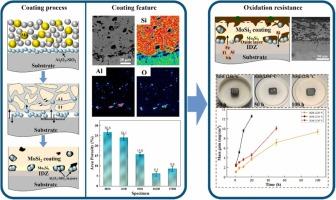界面上的 Al2O3-SiO2 膜对浆料烧结法在 Nb-Si 基合金上形成 MoSi2 涂层的微观结构和抗氧化性的影响
IF 5.8
2区 材料科学
Q2 CHEMISTRY, PHYSICAL
引用次数: 0
摘要
本研究旨在通过在烧结过程中在界面上引入 Al2O3-SiO2 薄膜作为扩散屏障(DB)来提高涂层密度。研究了界面处扩散阻挡层厚度对涂层密度、相组成和界面结构的影响。结果表明,Al2O3-SiO2 膜能有效减少硅的向内扩散,促进 MoSi2 涂层的致密化。增加 DB 的厚度可相应地提高扩散阻断效果。与无 DB 的 MoSi2 涂层相比,5 μm 厚 DB 涂层的面积孔隙率从 26.8% 降至 15.8%。氧化物 DB 在界面上呈不连续分布。然而,虽然涂层的密度明显增加,但当扩散屏障过厚时,还是出现了严重的裂纹。不含 DB 的涂层和含 3 和 5 μm 厚 DB 的涂层的微观结构基本相似,扩散间区(IDZ)由 Mo5Si3、Nb4Fe3Si5 和 (Nb,X)5Si3 三层组成。相比之下,厚度为 10 和 15 μm 的 DB 涂层的 IDZ 由单层 (Nb,X)5Si3 组成。与不含 DB 的 MoSi₂ 涂层相比,含 5 μm 厚 DB 的涂层的抗氧化性明显增强。涂层中的孔隙可以很快被形成的二氧化硅填满。带有 5 μm 厚 DB 的涂层在 1250 °C 下氧化 100 小时后的增重约为 9.4 mg/cm²,在 1350 °C 下氧化 50 小时后的增重约为 10.1 mg/cm²。本文章由计算机程序翻译,如有差异,请以英文原文为准。

Effect of Al2O3-SiO2 film at the interface on the microstructure formation and oxidation resistance of MoSi2 coating on Nb-Si based alloy via slurry sintering method
This study aims to improve the coating density by introducing Al2O3-SiO2 film as a diffusion barrier (DB) at the interface during the sintering process. The influence of the thickness of DB at the interface on the density, phase constituent and interface structure of the coating was studied. The results showed that the Al2O3-SiO2 film can effectively reduce the inward diffusion of Si, facilitating the densification of MoSi2 coating. Increasing the thickness of the DB correspondingly improves the diffusion blocking effect. Compared with the MoSi2 coating without DB, the area porosity of the coating with a 5 μm thick DB decreased from 26.8% to 15.8%. The oxide DB is discontinuously distributed at the interface. However, although the density of the coatings was markedly increased, severe cracking occurred when the diffusion barrier was excessively thick. The microstructure of coating without DB and coatings with 3 and 5 μm thick DB is generally similar, with the inter-diffusion zone (IDZ) consisting of Mo5Si3, Nb4Fe3Si5, and (Nb,X)5Si3 three layers. In contrast, the IDZ of coatings with 10 and 15 μm thick DB is comprised of a single (Nb,X)5Si3 layer. In comparison to the MoSi₂ coating without DB, the coating with a 5 μm thick DB exhibited a markedly enhanced oxidation resistance. The pores in the coating can be quickly filled by the as-formed SiO2. The weight gain of coating with a 5 μm thick DB is about 9.4 mg/cm² after oxidation at 1250 °C for 100 h, and about 10.1 mg/cm² after oxidation at 1350 °C for 50 h.
求助全文
通过发布文献求助,成功后即可免费获取论文全文。
去求助
来源期刊

Journal of Alloys and Compounds
工程技术-材料科学:综合
CiteScore
11.10
自引率
14.50%
发文量
5146
审稿时长
67 days
期刊介绍:
The Journal of Alloys and Compounds is intended to serve as an international medium for the publication of work on solid materials comprising compounds as well as alloys. Its great strength lies in the diversity of discipline which it encompasses, drawing together results from materials science, solid-state chemistry and physics.
 求助内容:
求助内容: 应助结果提醒方式:
应助结果提醒方式:


